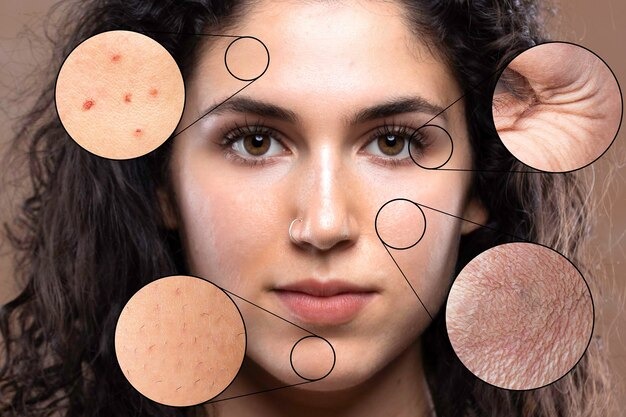INTRODUCTION
Skin color is determined by skin pigmentation, which is the amount of melanin produced by the body.
The two main types of melanin, eumelanin and pheomelanin, are produced by melanocytes in the epidermal layer of the skin pheomelanin is responsible for darker skin tones, and skin pigmentation, or the amount of melanin the body produces, determines the color of the skin.
The skin is protected from sunburn by the dark brown pigment eumelanin, which absorbs UV rays from the sun. Darker skin tones are related to higher levels of eumelanin, while lighter skin tones are associated with lower levels.
The rates of melanin synthesis vary across members of the same family, and between racial groups (Figure 1). This variation (MSH) is caused by genetics, sun exposure, and certain hormones that stimulate melanocytes, such as adrenocorticotropic hormone (ACTH), lipotropin, and melanocyte-stimulating hormone. Using more melatonin results in a grayish-brown skin tone.
Types of Skin Pigmentation Disorders
You may detect changes in your skin tone in various parts of your skin’s surface or simply in specific patches of skin. Skin pigment diseases, injuries, and other changes in your body can cause your skin to lighten, darken, or change in color.
Types of skin pigmentation include
- Hyperpigmentation
- Hypopigmentation
- Depigmentation
Hyperpigmentation
There are several factors that can contribute to hyperpigmentation:
- Sun Exposure: Ultraviolet (UV) radiation from the sun stimulates melanocytes to produce more melanin as a defense mechanism against the harmful effects of UV rays. Prolonged sun exposure can lead to the development of dark spots or sunspots on the skin.
- Hormonal Changes: Hormonal fluctuations, especially during pregnancy (melasma or chloasma) or as a result of birth control pills, can trigger an increase in melanin production. This type of hyperpigmentation is often referred to as hormonal or melasma pigmentation.
- Inflammation and Injury: Skin inflammation or injury, such as acne, can stimulate the production of melanin as part of the skin’s healing process. Post-inflammatory hyperpigmentation can result in dark spots or patches in the affected areas.
- Skin Aging: As the skin ages, there may be an accumulation of sun damage, and melanin production may become uneven, leading to age spots or liver spots.
- Genetic Factors: Some individuals may be genetically predisposed to developing hyperpigmentation. Certain skin types and ethnicities are more prone to conditions like melasma or freckles.
Hypopigmentation
Hypopigmentation refers to a condition where the skin or hair becomes lighter in color than the surrounding normal skin. This occurs due to a decrease or absence of melanin, the pigment responsible for skin, hair, and eye color. Melanin is produced by melanocytes, specialized cells located in the epidermis (outer layer of the skin).
There are several causes of hypopigmentation, and they can be broadly categorized into congenital (present from birth) and acquired (developed later in life) factors. Here are some common causes:
- Genetic Factors:
- Albinism: This is a genetic disorder characterized by a lack of melanin production. Individuals with albinism often have very light skin, hair, and eyes.
- Autoimmune Conditions:
- Vitiligo: Vitiligo is an autoimmune disorder in which the immune system mistakenly attacks and destroys melanocytes, leading to the development of white patches on the skin.
- Infections:
- Some infections can affect the melanocytes and lead to hypopigmentation. For example, pityriasis versicolor is a fungal infection that can cause light or dark patches on the skin.
- Inflammatory Skin Conditions:
- Certain inflammatory skin conditions, such as eczema or psoriasis, can lead to changes in pigmentation, including hypopigmentation.
- Chemical Exposure:
- Exposure to certain chemicals, especially those used in some topical treatments or hair dyes, can cause hypopigmentation.
- Trauma:
- Injury to the skin, such as burns or wounds, can sometimes result in hypopigmentation during the healing process.
- Neurological Factors:
- Some neurological disorders can affect the normal functioning of melanocytes, leading to changes in skin pigmentation.
- Medications:
- Certain medications, like some chemotherapeutic drugs, may cause changes in skin pigmentation, including hypopigmentation.
Treatment options for hypopigmentation depend on the underlying cause. In some cases, there may not be a cure, and treatment may focus on managing symptoms or improving the appearance of the affected skin. For example, topical corticosteroids, phototherapy, and cosmetic camouflage may be used to address the symptoms of vitiligo.
Depigmentation
Depigmentation refers to the process of lightening or reducing the pigmentation, or color, of the skin, hair, or other tissues in the body. This can occur naturally or as a result of various medical conditions, treatments, or cosmetic procedures. Here are some key aspects of depigmentation:
- Skin Depigmentation:
- Vitiligo: This is a common skin disorder where the immune system attacks and destroys melanocytes, the cells responsible for producing the pigment melanin. As a result, white patches of depigmented skin appear.
- Albinism: Albinism is a genetic condition characterized by a lack of melanin production. Individuals with albinism have very light or white skin, hair, and eyes due to the absence of pigmentation.
- Skin Lightening Treatments: Some individuals choose to undergo cosmetic procedures to lighten their skin tone. This may involve the use of topical creams, chemical peels, or laser treatments.
- Hair Depigmentation:
- Graying of Hair: As people age, their hair follicles produce less melanin, leading to the gradual loss of color in the hair. This natural process is known as graying.
- Hair Dyes: People may intentionally use hair dyes to change the color of their hair. These dyes can either deposit color or remove existing pigment from the hair shaft.
- Medical Conditions and Treatments:
- Certain Diseases: Some medical conditions, such as certain autoimmune disorders, can cause depigmentation as a secondary effect.
- Chemotherapy: Cancer treatments, particularly chemotherapy, can cause hair loss and changes in hair color due to damage to hair follicles.
- Cosmetic Depigmentation Procedures:
- Skin Lightening Products: Some individuals use topical creams or lotions containing ingredients like hydroquinone to lighten their skin. However, the use of such products should be approached with caution, as improper use can lead to side effects and health risks.
- Laser Therapy: Laser treatments can target pigmented cells in the skin, breaking down melanin and leading to a lighter skin tone. These procedures should be performed by trained professionals to minimize risks.
It’s important to note that while depigmentation may be a desired outcome in certain cosmetic procedures, it can also be associated with health conditions or side effects. Additionally, cultural and societal perspectives on skin color and depigmentation vary, and individuals should make informed choices based on their personal preferences and considerations.

